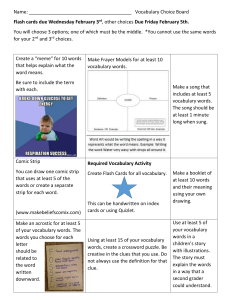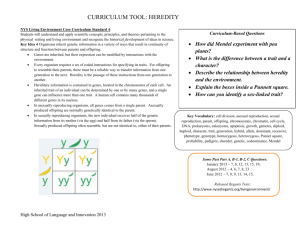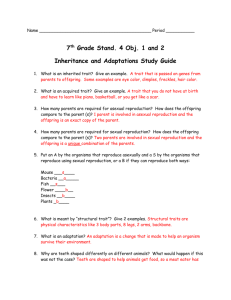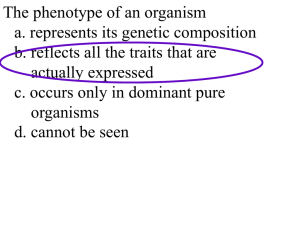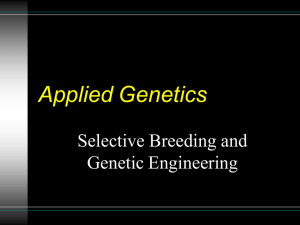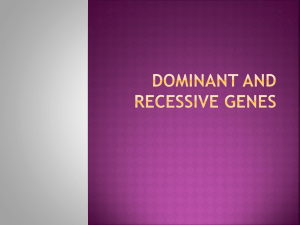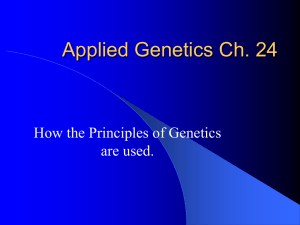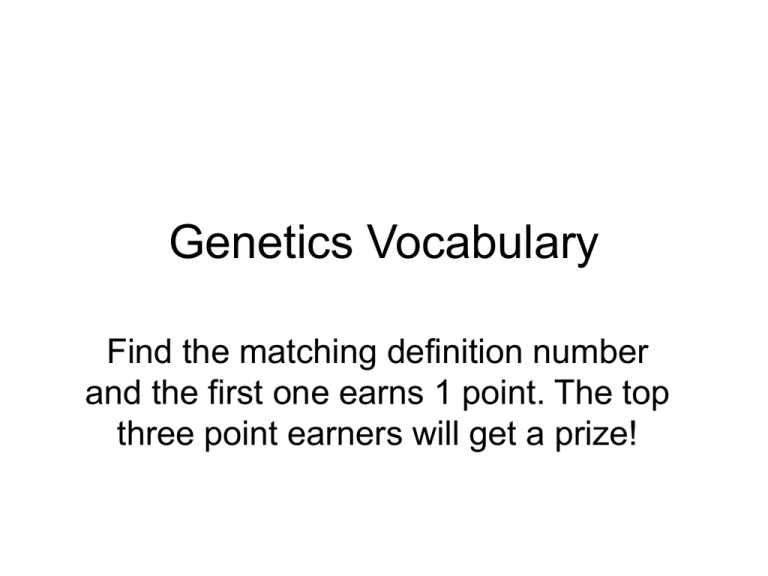
Genetics Vocabulary
Find the matching definition number
and the first one earns 1 point. The top
three point earners will get a prize!
Genotype
• the genetic characteristic, the organism’s
genetic makeup.
Selective Breeding
• the process of selecting a few organisms
with desired traits to serve as parents of
the next generation.
Trait
• a characteristic that an organism can pass
on to its offspring through its genes.
Allele
• alternate form of a gene for a trait; two or
more forms of the same gene, they may
be dominant or recessive.
Mendel
• The Father of Genetics. Used pea plants
to study the way traits are passed from
parent to offspring. He was the first to use
mathematics of probability to explain
heredity.
Punnett Square
• a tool to predict the chances of a trait by
using the allele combinations.
Genetic Engineering
• experimenting with biological and chemical
methods to change the arrangement of
DNA that makes up a gene can be used to
genetically alter plants, manufacture
proteins, and repair damaged genes.
Heterozygous
• an organism that has 2 different alleles for
a trait.
Heredity
• the passing of physical characteristics
from parents to offspring
Homozygous
• an organism that has 2 identical alleles for
a trait.
Mutation
• permanent change in a gene or
chromosome, changes the appearance or
function of the organism.
Phenotype
• the physical characteristic, how your
genetic makeup makes you look.
Human Genome Project
• Scientists identified the DNA sequence of
every gene in the human genome.
Genome is all of the DNA in one cell of an
organism.
Chromosomes
• place where genes are found
Dominant trait
• stronger trait; covers up the recessive trait,
the trait that always appears in firstgeneration offspring.
Base Pair
• these 4 nitrogen bases make up part of
the DNA molecule. Bases are Adenine,
Thymine, Cytosine, and Guanine.
Genetics
• the scientific study of heredity
Budding
• a form of asexual reproduction of yeast in
which a new cell grows out of the body of
a parent.
Meiosis
• takes place in sex cells, the number of
chromosomes is reduced by half. Four sex
cells produced.
Gene
• a certain section of DNA on a
chromosome, contains the set of
instructions for each characteristic
donated by the parent of the offspring.
They control an organism’s form and
function.
Probability
• the mathematical chance that an event will
occur.
Double Helix
• The shape of the DNA molecule (also
called a twisted ladder) and it is made up
of sugar phosphate molecules.
Stem Cell
• an unspecialized cell that gives rise to a
specific specialized cell, such as a blood
cell.
Recessive trait
• weaker trait; covered up by the dominant
trait, the trait that seems to recede in the
background in first-generation offspring.
Ex: sickle cell anemia
Watson and Crick
• first to make a model of the structure of
DNA.
Asexual reproduction
• a reproductive process involves only one
parent and produces offspring that are
identical to the parent.
Nitrogen Bases
• four kinds of bases that make up the rungs
of DNA. Adenine, Guanine, Cytosine, and
Thymine.
Franklin
• discovered that DNA was two chains of
molecules in spiral form.
DNA
• genetic material of an organism,
Deoxyribonucleic Acid, chemical that
contains the instructions for cells to
make the necessary protein. It has a
structure like a twisted ladder made
up of nucleotides.
Sex-linked genes
• a gene that is carried on the X or Y
chromosome.
Carrier
• a person who has one recessive allele for
a trait and one dominant allele. Carrier can
pass the recessive allele on to his or her
offspring. In sex-linked traits, only females
can be carriers.
Haploid
• a cell with half the original number of
chromosomes
Sexual reproduction
• a reproductive process that involves two
parents that combine their genetic material
to produce a new organism, which differs
from both parents.


